Skarżysko-Kamienna
Skarżysko-Kamienna pronounced [skarˈʐɨskɔ kaˈmʲɛnːa] (![]()
Skarżysko-Kamienna | |
|---|---|
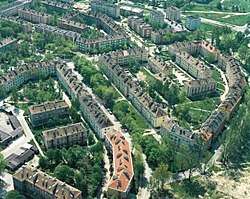 View at Skarżysko-Kamienna | |
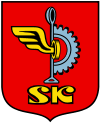 Coat of arms | |
 Skarżysko-Kamienna | |
| Coordinates: 51°7′N 20°55′E | |
| Country | |
| Voivodeship | Świętokrzyskie |
| County | Skarżysko |
| Gmina | Skarżysko-Kamienna (urban gmina) |
| Town rights | 1923 as Kamienna |
| Government | |
| • Mayor | Konrad Krönig |
| Area | |
| • City | 64.16 km2 (24.77 sq mi) |
| Elevation | 250 m (820 ft) |
| Population (2012) | |
| • City | 47,987 |
| • Density | 750/km2 (1,900/sq mi) |
| • Urban | 78,636 |
| Time zone | UTC+1 (CET) |
| • Summer (DST) | UTC+2 (CEST) |
| Postal code | 26-110 |
| Area code(s) | +48 41 |
| Car plates | TSK |
| Website | http://www.skarzysko.pl |
Skarżysko-Kamienna is an important railroad junction, with two main lines (Kraków - Warsaw and Sandomierz - Koluszki) crossing there.
History
In 1173, the knights' congress gathered in Milica village (now the town's district) led by Casimir II The Just. Around 1885 Kamienna became an important rail junction on the newly built Ivangorod-Dąbrowa Railway. The main line of the railway connecting Ivangorod (Dęblin) and Dąbrowa Górnicza ran through the town from north to south, and two branch lines to Ostrowiec Świętokrzyski and Koluszki radiated from the town east and west, respectively. This spurred the growth of Kamienna from a village into a sizeable town by 1920, when it had about 20 enterprises employing 1000 workers, as well as railway workshops employing an additional 1000 workers.[1]
Second Polish Republic
In 1923, the commune of Kamienna was granted the status of a town. In 1922 the government of Poland decided to build an ammunition factory in Kamienna, to be called Państwowa Wytwornia Uzbrojenia Fabryka Amunicji (P.W.U. Fabryka Amunicji, "National Armament Factory - Ammunition Plant") It began production in 1924 supplying munitions to the Polish Army. It employed 2760 workers in 1932, over 3000 in 1936, and over 4500 in 1939, becoming the principal employer in the town and driving its growth.[1] The company still functions today under the name Zakłady Metalowe MESKO S.A.).
In 1928, town's name was changed to Skarżysko-Kamienna. In 1937 the town had 19,700 inhabitants, among them 2,800 Jews (about 14% of the total).[2]
German occupation of Skarżysko-Kamienna (1939-1945)
Following the September 1939 invasion of Poland by Germany, Skarżysko-Kamienna was under German occupation until liberated by the Soviet army in January 1945. The Germans controlled the ammunition factory to support their own war effort, and from 1940 it was controlled by the company Hugo Schneider Aktiengesellschaft (HASAG), which ran it as a subcontractor for the Wehrmacht.[2] In 1940, the Germans carried out mass executions of Poles (360 people executed in February and 760 in June).[1]
The ghetto for the town's Jewish population was established by the Germans in April or May 1941. Between August 1942 and summer of 1943 Jews from the Radom district were brought to three camps near the munitions factory to work the factory. According to German records, of the total 17,210 brought in with 58 transports, 6,408 managed to survive long enough to be evacuated to other camps when the Germans closed the factory in 1944. The ghetto was liquidated in October 1942, with some inhabitants judged fit for work moved to the factory labour camps (about 500 out of 3000), and the rest were transported to Treblinka.[2] In the major monograph on the subject estimated that despite the incompleteness of German records which likely underestimate the number of inmates, about 25,000 Jewish inmates were brought to the camp and 7,000 were evacuated from it; about 18,000 died there.[3]
From 1945 to present
On January 18, 1945 the town was liberated. About a dozen Jewish survivors returned to Skarżysko-Kamienna in the winter of 1945-1946 to retrieve Jewish property.[2] Soon afterwards, in February 1946, five of them were murdered for profit by a small group of local criminals.[2][4] The murderers, among them the head of the Soviet-installed town police and another communist policeman, were put to trial in Łodź. Three of them received the death penalty. The remaining Jews left Poland,[5] except for Dr. Zundel Kahanel and his wife Bima who spent the rest of their lives in the city.[4]
Meanwhile, in 1948 the leading HASAG managers were tried in Leipzig, then in the part of Germany occupied by the Soviet Union. Of the 25 tried, 4 were sentenced to death, 2 to life in prison, and 18 to terms between one and five years.[2]
In 1969, The White Eagle Museum was established. In 1999, Skarżysko County was established as a result of the Local Government Reorganization Act (1998).
Mayors
Points of interest
- The White Eagle Museum (Polish: Muzeum im. Orła Białego) - a regional museum with a large outdoor display of military equipment, most items dating back to the World War II period.
- Indoor display - uniforms, ammunition, pistols and smaller guns, soldier equipment, photographs and documents
- Outdoor display - one of Poland's few ships displayed onshore (torpedo boat Odważny - The Brave), planes, tanks (including one of world's few preserved Sturmgeschütz IV vehicles), helicopters, cannons, etc.
- Several scenes of Steven Spielberg's Schindler's List were filmed at MESKO.
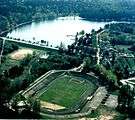 Rejów Lake and stadium
Rejów Lake and stadium.jpg) The Sacred Heart of Jesus Church
The Sacred Heart of Jesus Church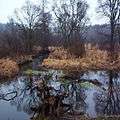 Kamienna River in Skarżysko
Kamienna River in Skarżysko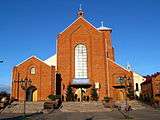 Sanctuaty Our Lady of the Gate of Dawn
Sanctuaty Our Lady of the Gate of Dawn
International relations
| Wikimedia Commons has media related to Skarżysko-Kamienna. |
Twin towns — Sister cities
Skarżysko-Kamienna is twinned with:
References
- Official city website - history section
- Geoffrey P. Megargee, Christopher Browning, Martin Dean,Encyclopedia of Camps and Ghettos, 1933–1945: Ghettos in German-Occupied Eastern Europe, Indiana University Press, 2012, pp. 308-311
- Felicja Karay, Death Comes in Yellow: Skarżysko-Kamienna Slave Labor Camp, Taylor & Francis, 1997
- Polin (2015). "Skarżysko-Kamienna". Spolecznosc Zydowska. Muzeum Historii Żydów Polskich POLIN. pp. 1/2. Retrieved 19 April 2015.
- Source: Pinkas Hakehilot Encyclopaedia of Jewish Communities, Poland, Vol. VII, Districts Lublin, Kielce, Yad Vashem, Martyrs' and Heros' Remembrance Authority, Jerusalem 1999
- Tadeusz Wojewoda: Samorząd terytorialny Skarżyska-Kamiennej w okresie międzywojennym. "Z dziejów regionu i miasta", R. 1/2010, p. 93.
- Tadeusz Wojewoda: Samorząd terytorialny Skarżyska-Kamiennej w okresie międzywojennym. "Z dziejów regionu i miasta", R. 1/2010, p. 95, 96, 99.
- Tadeusz Wojewoda: Samorząd terytorialny Skarżyska-Kamiennej w okresie międzywojennym. "Z dziejów regionu i miasta", R. 1/2010, p. 99.
- Tadeusz Wojewoda: Samorząd terytorialny Skarżyska-Kamiennej w okresie międzywojennym. "Z dziejów regionu i miasta", R. 1/2010, p. 100.
- Tadeusz Wojewoda: Samorząd terytorialny Skarżyska-Kamiennej w okresie międzywojennym. "Z dziejów regionu i miasta", R. 1/2010, p. 101, 102, 105.
- Tadeusz Wojewoda: Samorząd terytorialny Skarżyska-Kamiennej w okresie międzywojennym. "Z dziejów regionu i miasta", R. 1/2010, p. 105.
External links
- skarzysko.pl - official site of the town's municipality (in Polish, English, and German)
- Skarżysko-Kamienna, Poland at JewishGen
